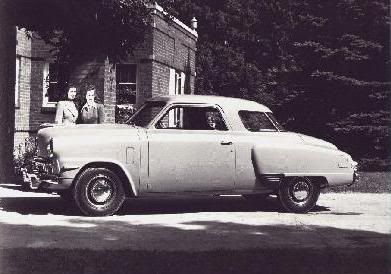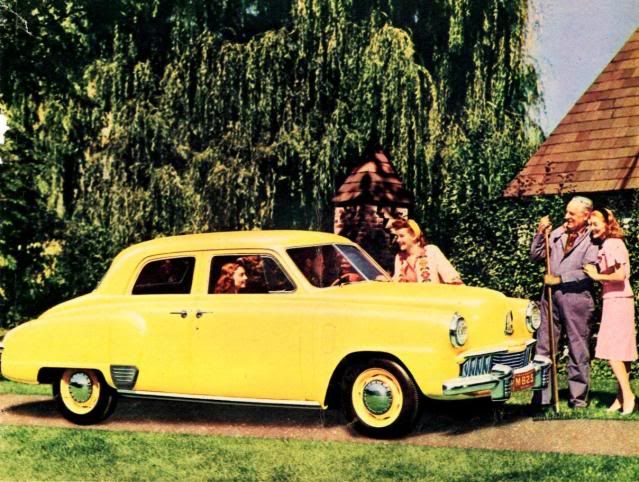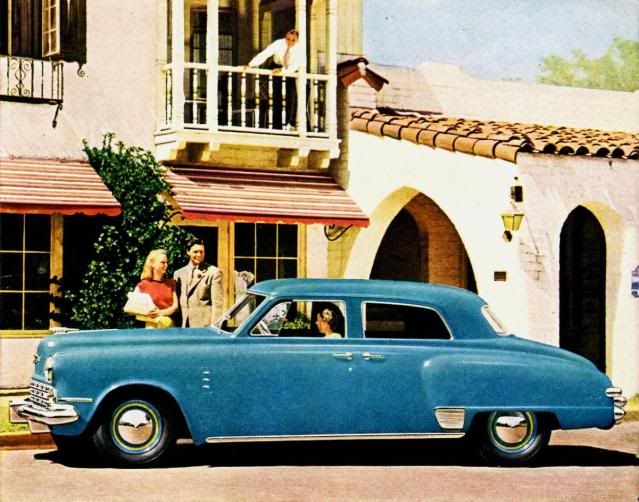Times are good for American automobile manufacturers, which struggle to keep up with the demand after four years of war. Nevertheless, all of their managers know that this situation will not last forever. This should not cause much concern among the three major corporations, but independent companies have to worry. Among them, Studebaker has decided to forge ahead of the competition, and to introduce a brand new line of models as early as May 1946. Their style is fresh and modern, with bodies much lower than their predecessor’s. Their look can be jointly credited to the outside consultant Raymond Loewy and designer Virgil Exner. A former member of Loewy's staff, Exner has left his job to join Studebaker when the project was already at an advanced stage, and only brought to it a new front end. The line includes the innovative 5-passenger coupe bodies, which feature a large, four-part rear window allowing light to freely enter into the car. This particular style, along with the convertible coupe, is now fitted with a one-piece curved windshield, instead of the traditional two pieces of flat glass used elsewhere.
Studebaker Champion DeLuxe
The Champion is traditionally Studebaker’s cheapest offer, and the DeLuxe is the plainest of the line. Its three-passenger coupe version is actually a business coupe.

● Introduction: May 1946. Construction: body on separate chassis. Engine: water-cooled inline six, 2.8-litre, 80 hp, mounted at the front. A high-compression version of this engine is available. Transmission: to the rear wheels through a three-speed manual gearbox. Suspension: independent at the front, rigid axle at the rear. Brakes: hydraulic, to drums on all four wheels. Length: 489 cm. Top speed: n/a. Range: two-door three-passenger coupe, two-door five-passenger coupe, two-door sedan, four-door sedan. Note: Studebaker’s brochure for 1947 also pictures a Champion DeLuxe two-door convertible coupe, but this model was not actually part of the range.
Studebaker Champion Regal DeLuxe
The Champion Regal DeLuxe adds bright stainless steel mouldings around the windows, along with stainless steel rocker panels. It remains otherwise rather similar to the Champion DeLuxe. A convertible is exclusive to this line.

● Introduction: May 1946. Construction: body on separate chassis. Engine: water-cooled inline six, 2.8-litre, 80 hp, mounted at the front. A high-compression version of this engine is available. Transmission: to the rear wheels through a three-speed manual gearbox. Suspension: independent at the front, rigid axle at the rear. Brakes: hydraulic, to drums on all four wheels. Length: 489 cm. Top speed: n/a. Range: two-door three-passenger coupe, two-door five-passenger coupe, two-door sedan, four-door sedan, two-door convertible coupe.
Studebaker Commander DeLuxe
The unveiling of the new Studebaker models sees the return of the Commander, now the company’s most expensive line as the prewar President seems to be gone for good. The Commander DeLuxe is set on a longer wheelbase, the extra length being used to house a larger six-cylinder engine, but its bodies are the same as the Champion’s from the cowl back. Its trim is similar to that of the Champion DeLuxe.

● Introduction: May 1946. Construction: body on separate chassis. Engine: water-cooled inline six, 3.7-litre, 94 hp, mounted at the front. A high-compression version of this engine is available. Transmission: to the rear wheels through a three-speed manual gearbox. Suspension: independent at the front, rigid axle at the rear. Brakes: hydraulic, to drums on all four wheels. Length: 519 cm. Top speed: n/a. Range: two-door three-passenger coupe, two-door five-passenger coupe, two-door sedan, four-door sedan.
Studebaker Commander Regal DeLuxe
The Commander Regal DeLuxe combines the chassis and engine of the Commander DeLuxe with the trim of the Champion Regal DeLuxe. Furthermore, it offers a specific model, the Land Cruiser sedan, which chassis is lengthened by ten centimetres for the benefit of the passengers’ legroom.

● Introduction: May 1946. Construction: body on separate chassis. Engine: water-cooled inline six, 3.7-litre, 94 hp, mounted at the front. A high-compression version of this engine is available. Transmission: to the rear wheels through a three-speed manual gearbox. Suspension: independent at the front, rigid axle at the rear. Brakes: hydraulic, to drums on all four wheels. Length: 519 cm (all models except Land Cruiser sedan), 529 cm (Land Cruiser sedan). Top speed: n/a. Range: two-door three-passenger coupe, two-door five-passenger coupe, two-door sedan, four-door sedan, four-door “Land Cruiser” sedan, two-door convertible coupe.
Any mistake you just spotted? A detail to add? A suggestion? Don’t hesitate to leave a comment!
Click to jump to another model year of the same car: 1947 – 1948 – 1949 – 1950 – 1951 – 1952
Click here to return to a list of all Studebaker vehicles presented on this blog.
Click here to return to this blog’s initial post, featuring a list of all vehicles already presented.
Studebaker Champion DeLuxe
The Champion is traditionally Studebaker’s cheapest offer, and the DeLuxe is the plainest of the line. Its three-passenger coupe version is actually a business coupe.

● Introduction: May 1946. Construction: body on separate chassis. Engine: water-cooled inline six, 2.8-litre, 80 hp, mounted at the front. A high-compression version of this engine is available. Transmission: to the rear wheels through a three-speed manual gearbox. Suspension: independent at the front, rigid axle at the rear. Brakes: hydraulic, to drums on all four wheels. Length: 489 cm. Top speed: n/a. Range: two-door three-passenger coupe, two-door five-passenger coupe, two-door sedan, four-door sedan. Note: Studebaker’s brochure for 1947 also pictures a Champion DeLuxe two-door convertible coupe, but this model was not actually part of the range.
Studebaker Champion Regal DeLuxe
The Champion Regal DeLuxe adds bright stainless steel mouldings around the windows, along with stainless steel rocker panels. It remains otherwise rather similar to the Champion DeLuxe. A convertible is exclusive to this line.

● Introduction: May 1946. Construction: body on separate chassis. Engine: water-cooled inline six, 2.8-litre, 80 hp, mounted at the front. A high-compression version of this engine is available. Transmission: to the rear wheels through a three-speed manual gearbox. Suspension: independent at the front, rigid axle at the rear. Brakes: hydraulic, to drums on all four wheels. Length: 489 cm. Top speed: n/a. Range: two-door three-passenger coupe, two-door five-passenger coupe, two-door sedan, four-door sedan, two-door convertible coupe.
Studebaker Commander DeLuxe
The unveiling of the new Studebaker models sees the return of the Commander, now the company’s most expensive line as the prewar President seems to be gone for good. The Commander DeLuxe is set on a longer wheelbase, the extra length being used to house a larger six-cylinder engine, but its bodies are the same as the Champion’s from the cowl back. Its trim is similar to that of the Champion DeLuxe.

● Introduction: May 1946. Construction: body on separate chassis. Engine: water-cooled inline six, 3.7-litre, 94 hp, mounted at the front. A high-compression version of this engine is available. Transmission: to the rear wheels through a three-speed manual gearbox. Suspension: independent at the front, rigid axle at the rear. Brakes: hydraulic, to drums on all four wheels. Length: 519 cm. Top speed: n/a. Range: two-door three-passenger coupe, two-door five-passenger coupe, two-door sedan, four-door sedan.
Studebaker Commander Regal DeLuxe
The Commander Regal DeLuxe combines the chassis and engine of the Commander DeLuxe with the trim of the Champion Regal DeLuxe. Furthermore, it offers a specific model, the Land Cruiser sedan, which chassis is lengthened by ten centimetres for the benefit of the passengers’ legroom.

● Introduction: May 1946. Construction: body on separate chassis. Engine: water-cooled inline six, 3.7-litre, 94 hp, mounted at the front. A high-compression version of this engine is available. Transmission: to the rear wheels through a three-speed manual gearbox. Suspension: independent at the front, rigid axle at the rear. Brakes: hydraulic, to drums on all four wheels. Length: 519 cm (all models except Land Cruiser sedan), 529 cm (Land Cruiser sedan). Top speed: n/a. Range: two-door three-passenger coupe, two-door five-passenger coupe, two-door sedan, four-door sedan, four-door “Land Cruiser” sedan, two-door convertible coupe.
Any mistake you just spotted? A detail to add? A suggestion? Don’t hesitate to leave a comment!
Click to jump to another model year of the same car: 1947 – 1948 – 1949 – 1950 – 1951 – 1952
Click here to return to a list of all Studebaker vehicles presented on this blog.
Click here to return to this blog’s initial post, featuring a list of all vehicles already presented.
No comments:
Post a Comment